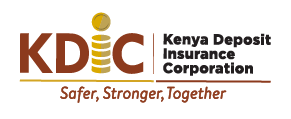
Crisis Preparedness and Bank Resolution Simulation (KDIC-101)- By Paul Manga; GM, Risk & Examination
The Corporation recently conducted a very successful internal training on ‘Crisis preparedness and bank resolution’ simulation for all staff. This exercise was a great milestone for the Corporation in terms of building its capacity for contingency planning. The training involved practical scenarios experienced when a bank is in financial distress – technically referred to as a “troubled bank”. Participants were first taken through a bank-establishment journey right from registration including the requisite documents required. As the institution continued to flourish making profits, a deposit insurance scheme was introduced, providing participants with a glimpse of how KDIC-as a safety-net player plays a critical role in insuring depositors, as part of its public policy objective of providing financial stability in Kenya.
During the training a hypothetical bank, whose target was largely the SME sector, was established. Since its inception, the bank with a sizeable market share in the country was considered to be a key player in the banking sector, serving small and medium-sized businesses.
Consequently, by 2020, the bank’s market share had grown to 1.3%. The hypothetical bank which operated in two cities-Nairobi and Mombasa- did not operate outside the country, but operated an ATM network with online digital banking services to its customers.
- Objectives of the training
The Program was designed to provide participants with tools to facilitate their surveillance role of early detection in the banking sector as well as early interventions necessary to protect the interest of depositors. The program further provided participants with an opportunity to KDIC’s as well as other safety-net players’ roles in managing a crisis in the sector arising from problems in a potentially systemic financial institution.
The case study helped participants to explore how different safety-net players coordinate with each other and with other authorities during a crisis. Further, it brought to the fore tools available for them to deal with the systemic consequences of a bank failure.
The training was designed to provide an opportunity for all staff both in technical and non-technical areas to have a first-hand experience of a bank failure. This experience will enable staff:
- To appreciate developed contingency plans and effective response to extraordinary situations (crisis).
- To appreciate various options of dealing with unexpected situations, maintain business continuity, and perform critical roles such as payouts, funding, recovery and resolution, and communication.
- To appreciate the tools available in resolving a bank.
- To appreciate resources required in resolving a bank.
- To appreciate our crisis communication strategy as part of contingency planning and crisis management;
- Training Activities
It was a three (3) day intensive training on crisis preparedness and bank resolution simulation workshop/training. Participants were taken through:
- Contingency Planning and Financial Crisis Preparedness.
- Basics on deposit insurance and its role as a safety net player for financial stability.
- Various indicators and early warning signs systems, to be tracked during surveillance of financial institutions.
- Various resolution options are available for institutions under financial distress including consideration of creditor compensation and various cost elements.
- Incorporated group exercises, tests, and simulations to expound on the theories
- Program outcome;
Participants learned how to use various indicators and approaches to carry out their
surveillance of financial institutions and the financial system as well as alert them of impending crises and attendant risks. They were also taught about assessments of systemically Important Financial Institutions (SIFIs), effective media management during a crisis, how to determine the most relevant resolution mechanism from available options available, including assessment of lesser cost rule.
- Methodology and facilitation.
The simulation exercise adopted a highly interactive approach, during which participants were exposed to case studies, presentations, simulations, and group activities As such, participants were able to:
- practice using processes of contingency planning and choosing among possible resolution options for dealing with troubled banks;
- co-ordinate with supervisors, central banks, and deposit insurers and with other authorities nationally and internationally in a crisis; and
- deal with systemic consequences of a bank failure. At the end of the Program, participants were able to examine the critical components of a crisis preparedness/contingency planning guide in the event of a financial crisis, in accordance with international best practices.







